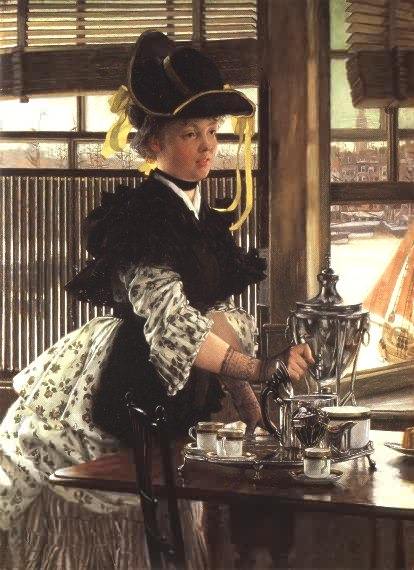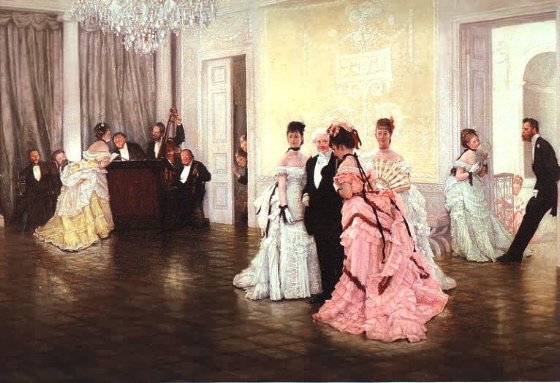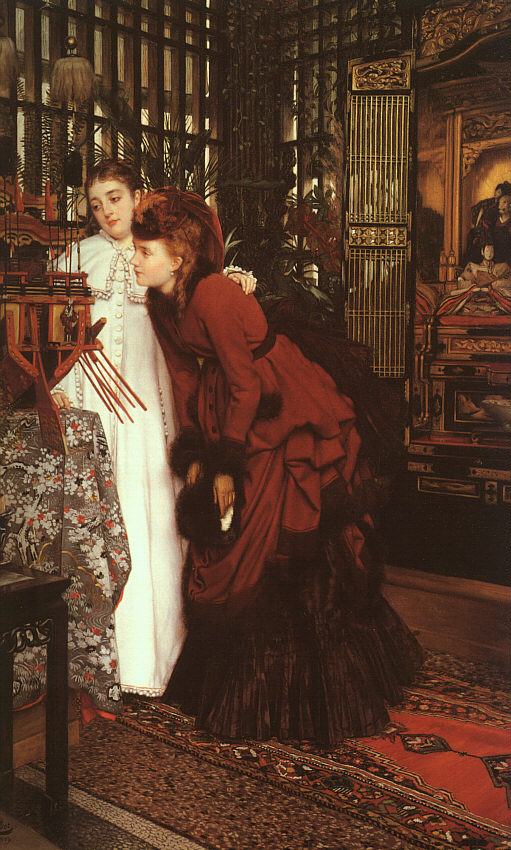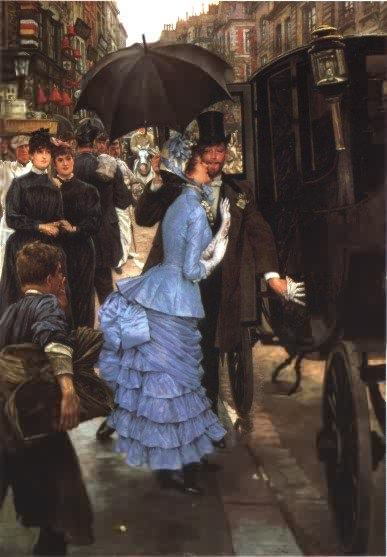James Tissot was known for two things — his immensely popular Bible
illustrations and his paintings of contemporary Victorian society.
My friend Paul Zahl says that the Bible illustrations influenced the
iconography of the early Hollywood Biblical epics, and he may be right,
but I’m not a big fan of these works, aesthetically speaking.
They’re drawn in a looser, more impressionistic and decorative style
than his easel paintings, and to me don’t have the same power.
The easel paintings strike me as downright stunning. In them the
use of an almost photographic draftsmanship and sometimes subtle but always highly
dramatic evocations of spatial depth result in works that utterly
enchant me.

Tissot had a number of compositional strategies for producing an
impression of spatial depth. The most characteristic was the
depiction of semi-enclosed spaces with portals onto wider spaces
beyond, which cause the eye to come to rest momentarily in the
foreground space and then to explore the background space, which
reveals itself almost as a surprise, a release.
Tissot also had a knack for compositions involving larger groups in a
public space, like a ballroom, in which the empty areas of the scene
suggest the potential for action within it. The strategy is very
explicit in the painting below, Too Early, in which the future of
the evening unfolds like a ghostly vision around the few early arrivals
waiting for the festivities to begin.

This is a perfect example of how visual space can be charged with
emotion — we populate the half-empty ballroom with future dancing, just as
the early arrivals do . . . we enter into the emotional anticipation of
these folks who’ve arrived a little too soon.

Tissot’s genius at suggesting depth through composition and modeling
also allowed him to produce canvases which shimmer with surface colors,
like the canvases of the Impressionists, but almost simultaneously draw
our imaginations irresistibly into the space depicted — something the
Impressionists were rarely concerned to do. The effect is
magical, and one that movies would soon learn to achieve in more
spectacular ways than the academic Victorian painters had at their
command. Their most potent charm was appropriated, and their
school of painting faded into history.
But when we look at Tissot’s paintings today, when our imaginations are
drawn into the spaces of his world, we can achieve a remarkable sense
of intimacy with the Victorian society he observed, we can share the
concerns and sometimes even the emotions of its long-vanished
inhabitants . . . and there’s an enchantment in that which will never
fade.


I've been studying 19th century art for a while, so I wanted to point you to something you might find interesting.
Tissot was the student of a Belgian artist, Henri Leys. What makes Leys interesting that he was a historicist in that he mainly focused on creating paintings based on the history of the area, but in creating his paintings in order to express the sense of the era more, he half adopted an archaic 16th century style, severely flattened with distorted perspective and more solid coloring. Think of painters from that time like Brueghel.
( http://www.artrenewal.org/asp/database/image.asp?id=15145 )
What makes the connection to Tissot interesting, is that Tissot seemed almost obsessive about capturing and representing the style around him in his age.
Leys was also the teacher of Alma Tadema
Very interesting indeed! And very odd that both Tissot and Alma-Tadema should have studied with him — because they both became so concerned with creating images that would convey an impression of deep space and optical integrity. They shared his concern with historical accuracy but moved away from his method of echoing painterly practice from the historical period presented.
Your blog is incredible. I've stumbled across a treasure trove.
So far, ArtMagick has been one of my favorite source's, but *this*… Wow….
Thank you!
Thanks for the kind words! Your blog is great, too — I really enjoyed browsing around in it . . .
Hello I have just come across your incredible blog really enjoyed these paintings and I did not know of the painter James Tissot. His paintings are wonderful. I have a Pinterest board where I pin beautiful paintings and sketches would you mind if I pinned a couple of your James Tissot paintings.
Thank you for sharing.
They should be shared!
Thank you !. I will be back to see more of your wonderful blog.